VIDEO: Should I Be Worried if My Neighbor Has Carpenter Ants?
It’s a nice day. You’re cleaning up your house and as you're washing your hands at the bathroom sink, you notice something moving on the floor. Could’ve just been a trick of the light or maybe just a speck of dirt.
And then you see it clear as day parading around the floor: a carpenter ant. Not one of those small ants; a big one.
You smash it and think your problems are over.
But they could be just beginning. Carpenter ants are known to send out scouts to find food; so you’ll never see them crawling around your home in large numbers. You’ll likely only see a single ant here or there. Ants rarely travel alone.
Use This Tool to Compare Your Local Pest Control Companies
Worried you might be seeing signs of carpenter ants? Let’s talk about how you can tell if you have a problem and what you can do to control it.
My Neighbor Has Carpenter Ants - Should I Worry?
If you were to find out that your neighbor had carpenter ants, you might get concerned.
After all, they do have that large log pile in their backyard. What if that close proximity means those ants come looking for more food and shelter at your home? You definitely don’t want to deal with ants.
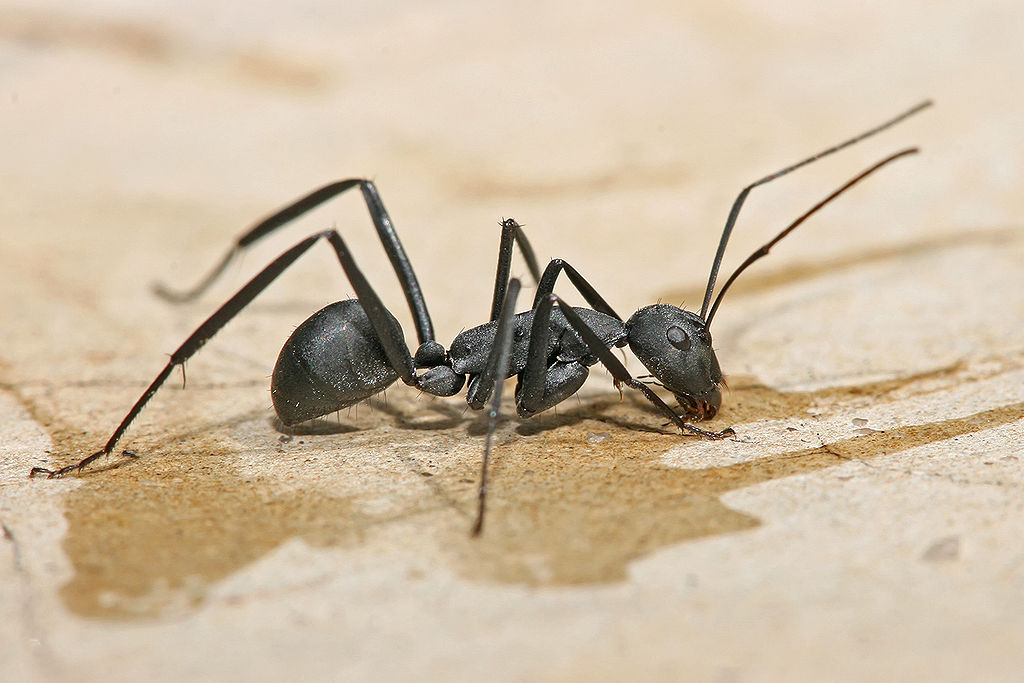
Good news: The carpenter ants in your neighbor’s yard probably aren’t going to come over and bother you … unless you have something they want.
Carpenter ants like certain conditions. Let’s review the main signs of carpenter ants so you know how to keep these pests at bay.
Moist Wood
Carpenter ants like moist, rotting wood. Specifically, they are usually found in door and window frames or sills, where higher moisture and humidity linger. They also like decks, porches, patios, fences, and sheds.
If your home is older or has any wood that is soft, water-damaged, or has wood rot, checking for carpenter ants -- particularly if you know they are already nearby at the neighbor's house -- is probably a good idea, especially if you see ants.
When carpenter ants tunnel into your wood, they chew it and build nests. They don’t eat your wood; they just hang out in it. But the constant tunnelling, especially with larger populations, can cause structural damage.
Signs of carpenter ants here would be wood shavings, light rustling in your walls, or sagging wood.
Ant Sightings
Carpenter ants are the largest species of ants that nest in homes.
Compared to the common ants you see outside that are ⅛ of an inch long, carpenter ants can be up to ⅝ of an inch long. This size makes them pretty obvious to the naked eye.
While spotting an ant might not be a sure sign you have an infestation, if it comes with wood shavings then it could be a bigger indication you need to get rid of carpenter ants.
Signs of Carpenter Ants Near Food
Carpenter ants need food. So you may spot them near kitchen hotspots. These include pantries, spots where crumbs fall, and near pet food.
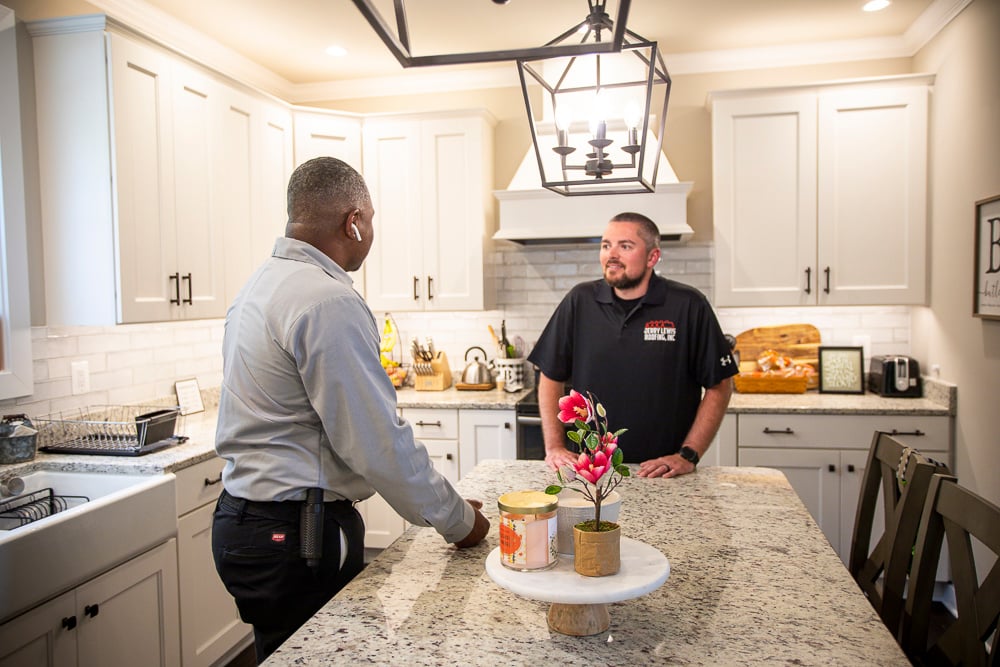
Ants are typically more attracted to sugars and uncovered foods.
Protect Your Home From Carpenter Ants
Now that you know a little bit about common signs of carpenter ants, it’s time to learn how to get rid of them.
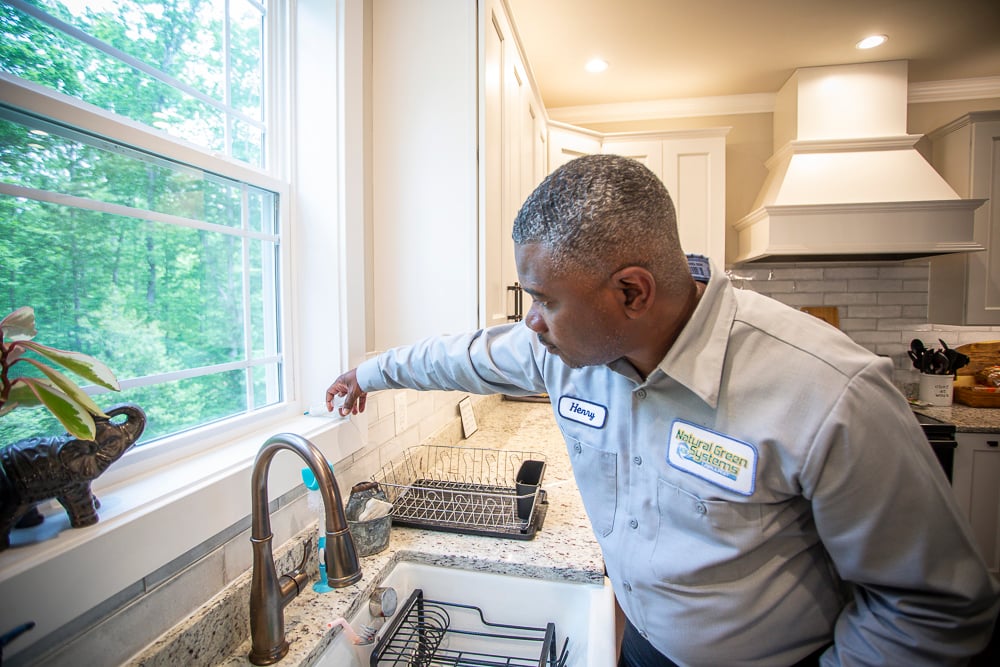
Let’s begin with some prevention tips:
- Minimize moisture by fixing water leaks and ensuring gutters and downspouts guide rain away from your house. The more you have areas with wood that can get wet, the more attractive your home will be to carpenter ants.
- Seal holes where wires or pipes enter the home and caulk gaps in windows, doors, or foundation cracks to help keep carpenter ants from coming in.
- Keeping your kitchen clean can help prevent ants. Store foods in airtight containers, clean spills and sweep up crumbs, and take care of trash removal.
- While you're storing your food, don’t forget to store your pet’s food in airtight containers as well.
- Prune trees or shrubs near your home so they don’t touch the house, causing potential additional moisture buildup and enabling ants to use branches to get inside.
- Firewood is a common ant hangout. Stack firewood at least 20 feet from your home.
If you follow the above tips, and are still seeing signs of carpenter ants, it may be time for additional control techniques.
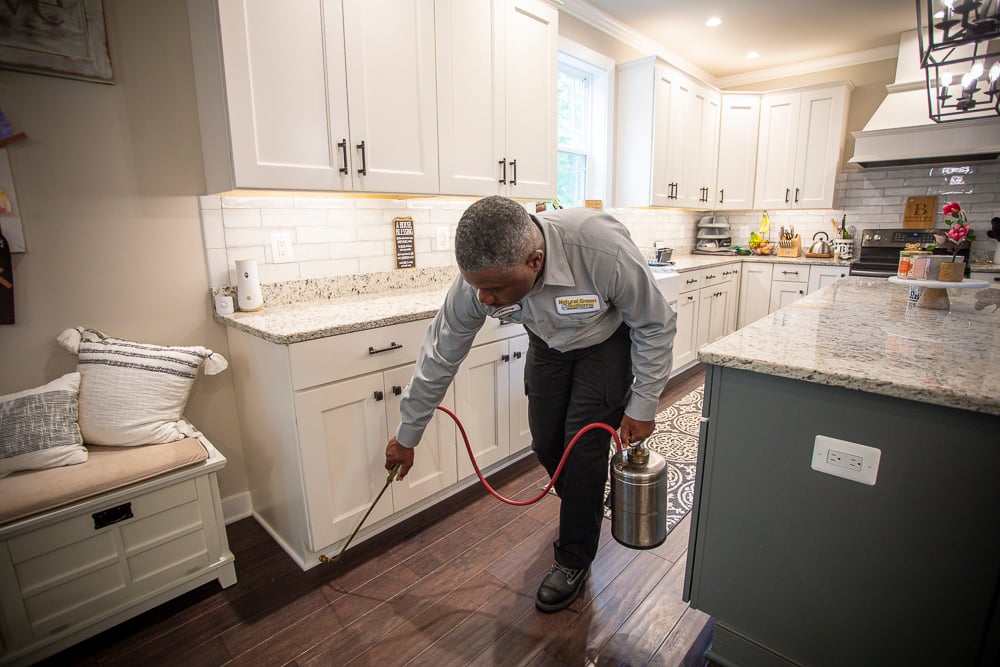
Pest control professionals can use contact insecticides to control an ant population in your home or non-repellant ant control products that are designed so ants grab a hidden protein or sugar source and take the bait back to their nest, impacting the colony.
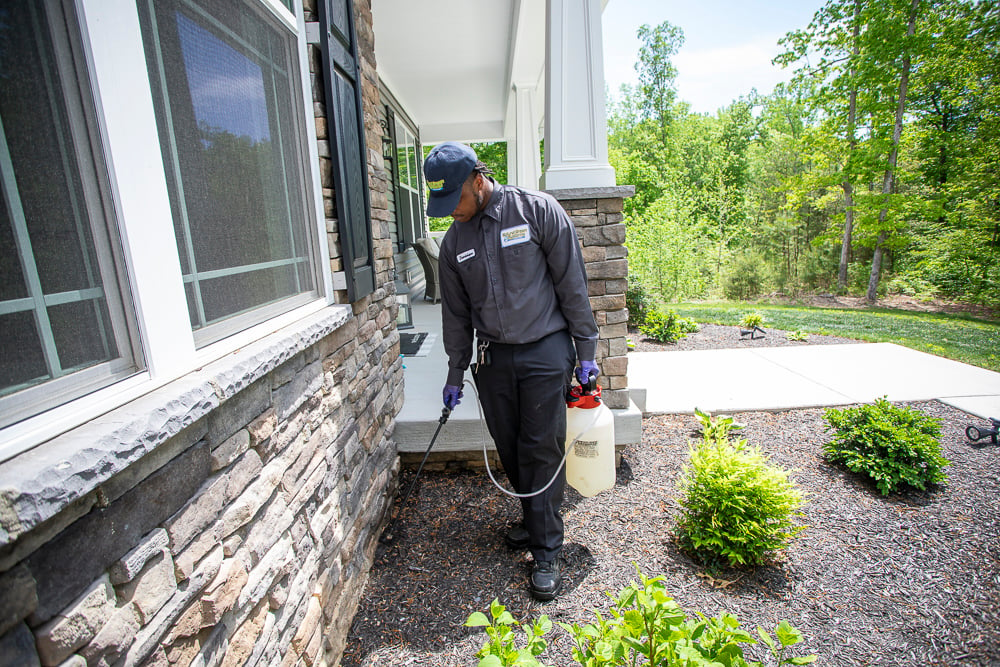
Then, after your carpenter ant infestation is under control, barrier treatments can help keep them away. These treatments use a smell or taste ants dislike so once they approach it they won’t go further toward your home.
Get Rid of Carpenter Ants For Good
Carpenter ants are not only a nuisance, but they can also grow in large numbers and end up causing structural damage to your home. It’s definitely not a fun experience to find that your door frames are warping or your windows aren’t opening as easily because ants are tunneling through your wood.
Don’t let a carpenter ant problem get out of control. If you can’t seem to get a handle on your problem, let Natural Green help. We can offer a complete proactive pest control program that includes an inspection and treatment plan to eliminate those carpenter ants and keep them from coming back.
Are carpenter ants ruining your day? We can help you take back control of your Central or Southern Maryland home. Get started today with a free quote. Together, we’ll prepare a custom plan that is the best choice for you.
It’s a nice day. You’re cleaning up your house and as you're washing your hands at the bathroom sink, you notice something moving on the floor. Could’ve just been a trick of the light or maybe just a speck of dirt.
And then you see it clear as day parading around the floor: a carpenter ant. Not one of those small ants; a big one.
You smash it and think your problems are over.
But they could be just beginning. Carpenter ants are known to send out scouts to find food; so you’ll never see them crawling around your home in large numbers. You’ll likely only see a single ant here or there. Ants rarely travel alone.
Use This Tool to Compare Your Local Pest Control Companies
Worried you might be seeing signs of carpenter ants? Let’s talk about how you can tell if you have a problem and what you can do to control it.
My Neighbor Has Carpenter Ants - Should I Worry?
If you were to find out that your neighbor had carpenter ants, you might get concerned.
After all, they do have that large log pile in their backyard. What if that close proximity means those ants come looking for more food and shelter at your home? You definitely don’t want to deal with ants.

Good news: The carpenter ants in your neighbor’s yard probably aren’t going to come over and bother you … unless you have something they want.
Carpenter ants like certain conditions. Let’s review the main signs of carpenter ants so you know how to keep these pests at bay.
Moist Wood
Carpenter ants like moist, rotting wood. Specifically, they are usually found in door and window frames or sills, where higher moisture and humidity linger. They also like decks, porches, patios, fences, and sheds.
If your home is older or has any wood that is soft, water-damaged, or has wood rot, checking for carpenter ants -- particularly if you know they are already nearby at the neighbor's house -- is probably a good idea, especially if you see ants.
When carpenter ants tunnel into your wood, they chew it and build nests. They don’t eat your wood; they just hang out in it. But the constant tunnelling, especially with larger populations, can cause structural damage.
Signs of carpenter ants here would be wood shavings, light rustling in your walls, or sagging wood.
Ant Sightings
Carpenter ants are the largest species of ants that nest in homes.
Compared to the common ants you see outside that are ⅛ of an inch long, carpenter ants can be up to ⅝ of an inch long. This size makes them pretty obvious to the naked eye.
While spotting an ant might not be a sure sign you have an infestation, if it comes with wood shavings then it could be a bigger indication you need to get rid of carpenter ants.
Signs of Carpenter Ants Near Food
Carpenter ants need food. So you may spot them near kitchen hotspots. These include pantries, spots where crumbs fall, and near pet food.

Ants are typically more attracted to sugars and uncovered foods.
Protect Your Home From Carpenter Ants
Now that you know a little bit about common signs of carpenter ants, it’s time to learn how to get rid of them.

Let’s begin with some prevention tips:
- Minimize moisture by fixing water leaks and ensuring gutters and downspouts guide rain away from your house. The more you have areas with wood that can get wet, the more attractive your home will be to carpenter ants.
- Seal holes where wires or pipes enter the home and caulk gaps in windows, doors, or foundation cracks to help keep carpenter ants from coming in.
- Keeping your kitchen clean can help prevent ants. Store foods in airtight containers, clean spills and sweep up crumbs, and take care of trash removal.
- While you're storing your food, don’t forget to store your pet’s food in airtight containers as well.
- Prune trees or shrubs near your home so they don’t touch the house, causing potential additional moisture buildup and enabling ants to use branches to get inside.
- Firewood is a common ant hangout. Stack firewood at least 20 feet from your home.
If you follow the above tips, and are still seeing signs of carpenter ants, it may be time for additional control techniques.

Pest control professionals can use contact insecticides to control an ant population in your home or non-repellant ant control products that are designed so ants grab a hidden protein or sugar source and take the bait back to their nest, impacting the colony.

Then, after your carpenter ant infestation is under control, barrier treatments can help keep them away. These treatments use a smell or taste ants dislike so once they approach it they won’t go further toward your home.
Get Rid of Carpenter Ants For Good
Carpenter ants are not only a nuisance, but they can also grow in large numbers and end up causing structural damage to your home. It’s definitely not a fun experience to find that your door frames are warping or your windows aren’t opening as easily because ants are tunneling through your wood.
Don’t let a carpenter ant problem get out of control. If you can’t seem to get a handle on your problem, let Natural Green help. We can offer a complete proactive pest control program that includes an inspection and treatment plan to eliminate those carpenter ants and keep them from coming back.
Are carpenter ants ruining your day? We can help you take back control of your Central or Southern Maryland home. Get started today with a free quote. Together, we’ll prepare a custom plan that is the best choice for you.
Image Source: ants
Share This
It’s a nice day. You’re cleaning up your house and as you're washing your hands at the bathroom sink, you notice something moving on the floor. Could’ve just been a trick of the light or maybe just a speck of dirt.
And then you see it clear as day parading around the floor: a carpenter ant. Not one of those small ants; a big one.
You smash it and think your problems are over.
But they could be just beginning. Carpenter ants are known to send out scouts to find food; so you’ll never see them crawling around your home in large numbers. You’ll likely only see a single ant here or there. Ants rarely travel alone.
Use This Tool to Compare Your Local Pest Control Companies
Worried you might be seeing signs of carpenter ants? Let’s talk about how you can tell if you have a problem and what you can do to control it.
My Neighbor Has Carpenter Ants - Should I Worry?
If you were to find out that your neighbor had carpenter ants, you might get concerned.
After all, they do have that large log pile in their backyard. What if that close proximity means those ants come looking for more food and shelter at your home? You definitely don’t want to deal with ants.

Good news: The carpenter ants in your neighbor’s yard probably aren’t going to come over and bother you … unless you have something they want.
Carpenter ants like certain conditions. Let’s review the main signs of carpenter ants so you know how to keep these pests at bay.
Moist Wood
Carpenter ants like moist, rotting wood. Specifically, they are usually found in door and window frames or sills, where higher moisture and humidity linger. They also like decks, porches, patios, fences, and sheds.
If your home is older or has any wood that is soft, water-damaged, or has wood rot, checking for carpenter ants -- particularly if you know they are already nearby at the neighbor's house -- is probably a good idea, especially if you see ants.
When carpenter ants tunnel into your wood, they chew it and build nests. They don’t eat your wood; they just hang out in it. But the constant tunnelling, especially with larger populations, can cause structural damage.
Signs of carpenter ants here would be wood shavings, light rustling in your walls, or sagging wood.
Ant Sightings
Carpenter ants are the largest species of ants that nest in homes.
Compared to the common ants you see outside that are ⅛ of an inch long, carpenter ants can be up to ⅝ of an inch long. This size makes them pretty obvious to the naked eye.
While spotting an ant might not be a sure sign you have an infestation, if it comes with wood shavings then it could be a bigger indication you need to get rid of carpenter ants.
Signs of Carpenter Ants Near Food
Carpenter ants need food. So you may spot them near kitchen hotspots. These include pantries, spots where crumbs fall, and near pet food.

Ants are typically more attracted to sugars and uncovered foods.
Protect Your Home From Carpenter Ants
Now that you know a little bit about common signs of carpenter ants, it’s time to learn how to get rid of them.

Let’s begin with some prevention tips:
- Minimize moisture by fixing water leaks and ensuring gutters and downspouts guide rain away from your house. The more you have areas with wood that can get wet, the more attractive your home will be to carpenter ants.
- Seal holes where wires or pipes enter the home and caulk gaps in windows, doors, or foundation cracks to help keep carpenter ants from coming in.
- Keeping your kitchen clean can help prevent ants. Store foods in airtight containers, clean spills and sweep up crumbs, and take care of trash removal.
- While you're storing your food, don’t forget to store your pet’s food in airtight containers as well.
- Prune trees or shrubs near your home so they don’t touch the house, causing potential additional moisture buildup and enabling ants to use branches to get inside.
- Firewood is a common ant hangout. Stack firewood at least 20 feet from your home.
If you follow the above tips, and are still seeing signs of carpenter ants, it may be time for additional control techniques.

Pest control professionals can use contact insecticides to control an ant population in your home or non-repellant ant control products that are designed so ants grab a hidden protein or sugar source and take the bait back to their nest, impacting the colony.

Then, after your carpenter ant infestation is under control, barrier treatments can help keep them away. These treatments use a smell or taste ants dislike so once they approach it they won’t go further toward your home.
Get Rid of Carpenter Ants For Good
Carpenter ants are not only a nuisance, but they can also grow in large numbers and end up causing structural damage to your home. It’s definitely not a fun experience to find that your door frames are warping or your windows aren’t opening as easily because ants are tunneling through your wood.
Don’t let a carpenter ant problem get out of control. If you can’t seem to get a handle on your problem, let Natural Green help. We can offer a complete proactive pest control program that includes an inspection and treatment plan to eliminate those carpenter ants and keep them from coming back.
Are carpenter ants ruining your day? We can help you take back control of your Central or Southern Maryland home. Get started today with a free quote. Together, we’ll prepare a custom plan that is the best choice for you.
Image Source: ants
Share This
Topics: Pest Control, Video


